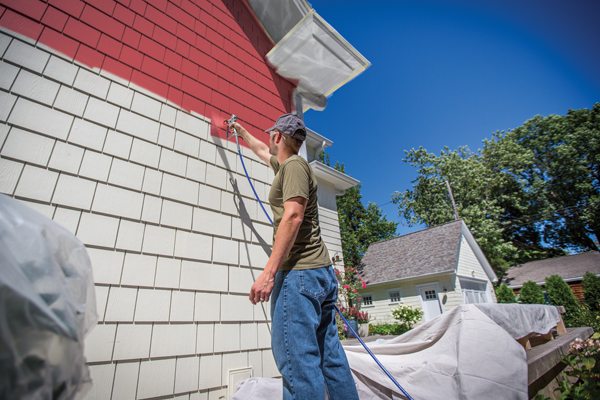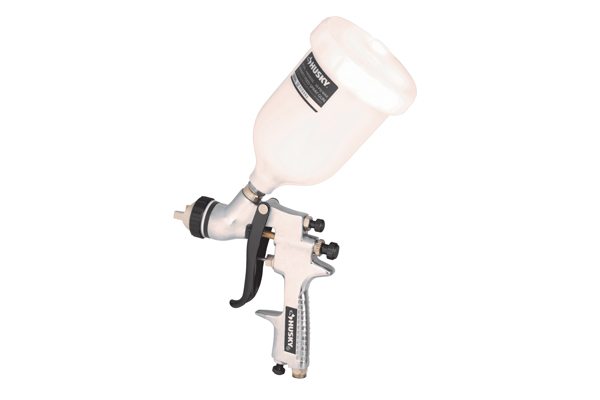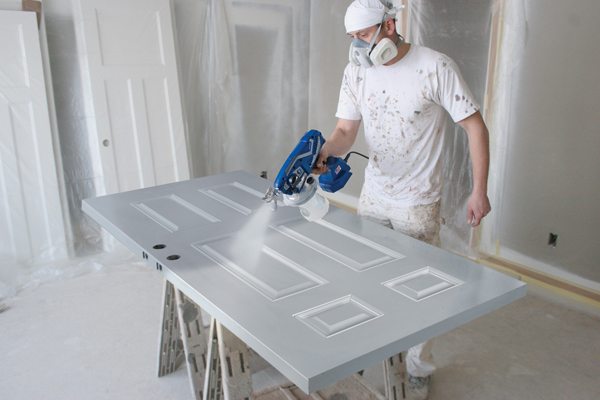
Are you Paint Sprayer Savvy?
When a paint sprayer savvy take necessary precautions and follow proper guidelines, many painting jobs can be more efficient when using a paint sprayer. Pros can ramp up efficiency on many painting jobs by using paint sprayers rather than traditional methods. Here’s how to be a paint sprayer savvy.
By Peter Fabris
Rodrigo Campos proudly shows off a drone video taken above a large colonial home that his company, Pro House Painters, recently painted. Campos, the owner of the Marlborough, Mass., paint contracting firm, is excited to use the new technology as a marketing tool. His company relies on another technology, paint sprayers, however, to perform its work every day.
Though paint sprayers may not be as sexy as flying robots equipped with cameras, they are indispensable to Pro House Painters and thousands of other painting contractors in the United States. And, more and more, other construction professionals such as handymen and maintenance workers who paint part of the time are turning to sprayers and are becoming paint sprayer savvy. While paint rollers and brushes are still important pieces of a painter’s tool kit, recent innovations in the sprayer market have made them easier to use, clean and maintain. The result has been increased use of paint sprayers, with rollers and brushes relegated to supporting roles.
That’s because when used properly under the right circumstances, paint sprayers present key advantages over rollers and brushes. No other method is faster in applying paint. Sprayers paint a surface at least four-times faster than rollers. Paint sprayers also coat uneven surfaces like windows and stair balusters quickly and evenly. They can create a mirror-like finish on fine furniture or cabinets – surfaces where brush marks would spoil the effect.
With those advantages come some drawbacks, though. Prep work is usually more extensive when using paint sprayers. Because sprayers produce tiny droplets of paint that travel through the air, every surface that will not be painted must be masked. Pressure must be adjusted carefully to get a desired flow of paint to cover an area completely without pooling into drips. It takes some experience to make the proper adjustments and to move the sprayer at the right pace and in the right pattern to produce the best results.
In addition, sprayers can consume a lot of paint. Some of the tiny droplets of sprayed paint drift away from the intended surface, so some paint is wasted. This adds cost to a project. The machines also must be cleaned thoroughly and are not always easy to clean, although this is easier than it used to be. An improperly cleaned paint sprayer can become clogged and stop working.
For interiors, paint sprayers are best suited for use in newly constructed buildings, particularly before floors have been finished. If there are no furnishings to mask or flooring to cover with drop cloths, the masking process goes much faster. You can quickly prime large areas of ceilings and walls, and add further coats of paint in short order. When renovating interiors, though, the need for a full masking of the interior may make the overall effort to prep for spraying not worth the time. Good old rollers and brushes may be just as fast and effective, depending on the size of the project.
Exterior effectiveness
Paint sprayers are often the best choice on exteriors, though. Outside, there are typically fewer areas requiring masking, and sprayers make it easier to cover hard-to-reach areas, such as eaves. Sprayers are particularly well suited to a project like painting a long privacy fence or a large deck. For some uneven surfaces, such as cedar shingles with crevices, it might be necessary to back brush a sprayed area to make sure that paint covers the surface thoroughly.
One problem when spraying outdoors is coping with wind. If the breeze is too strong, say, a constant breeze above 10 mph, you might have to thoroughly mask nearby vehicles or structures like lamp posts. If you’re spraying in proximity to cars (at an office building, for instance), you’ll have to mask the entire vehicle. “We’ll get authorization in advance to wrap the cars with plastic,” Campos says.

Recent innovations in the sprayer market have made them easier to use, clean and maintain, resulting in an increased use of sprayers.
Airless or air-driven?
When choosing a paint sprayer, keep in mind that there are two basic categories of paint sprayers: airless and those driven by air. Generally speaking, paint sprayers driven by air are best suited to smaller applications on areas such as crown molding, mantels and fine cabinetry. HVLP (High Volume Low Pressure) air-driven sprayers carry droplets of paint on a steady, large volume of air. Paint travels slower using these sprayers than on airless models. More droplets stick to the surface, resulting in a smooth finish, suitable for high-end residential projects. These models are also good for applying stain, lacquer, polyurethane and other finish products, and they have become staples in shop settings.

Spray tips have improved noticeably for more even, precise spraying, and innovations in accessories have also occurred.
“The lower velocity of the atomizing air stream results in a more controlled spray pattern, less bounce back, and enhanced transfer efficiency,” says Darryl Tieken, paint sprayer savvy and product development merchant, HUSKY Spray Guns. “Some disadvantages to this equipment include: higher initial cost, inability to atomize coatings as finely as can be achieved with conventional spray guns, and slower application speed.”

Users must, at the least, wear a respirator mask to prevent breathing in tiny paint droplets that may have traveled through the air.
Image courtesy of Graco
Airless paint sprayers, driven by built-in pumps, are the workhorses for most professional house and commercial building painters. About 95 percent of professional painters have an airless sprayer in their tool kits, says Kate Grathwohl, global product marketing manager for Graco, a prominent maker of paint sprayers. Graco monitors sales and product registration to understand how many professionals use its products and estimates that about 40 percent of construction and maintenance specialists who paint also use airless sprayers.

Start moving the paint sprayer before you pull the trigger, and continue the stroke after releasing the trigger so that paint doesn’t build up at the edges of the surface.
Image courtesy of Graco
Paint sprayer enhancements
Airless paint sprayers are geared toward construction and maintenance Pros who paint as part of their jobs. New features introduced in the past few years have made airless sprayers easier to maintain and clean. For instance, the use of a liner bag can simplify cleanup for hand-held sprayers by keeping the cup holding the paint clean.
In recent years, manufacturers’ research and development teams have stepped up their games in other ways. “We are constantly looking for ways to improve our performance through enhanced features and benefits for our customers,” Tieken says. Campos says spray tips have improved noticeably, allowing for more even, more precise spraying. There also have been some innovations in paint sprayers accessories.
Using a paint sprayer for crown molding
Pro House Painters recently started using a new guide to paint crown molding in a 5,000-square-foot Massachusetts home. The guide can be used with sprayer on a standard pole and applies material precisely enough that masking of the ceiling and wall wasn’t necessary, Campos says. “We were able to paint the crown molding in one day, and that would have taken us four or five days with brushes,” he says.
Safety precautions when using paint sprayers
With all the rewards of using paint sprayers, it’s important to consider safety precautions. Sprayers present hazards that don’t apply to paint rollers and brushes. Every sprayer causes some overspray, meaning particles of paint travel through the air and do not all reach their intended target. Users must, at the least, wear a respirator mask and eye protection to prevent breathing in tiny paint droplets and ensure that the material doesn’t make contact with their eyes. In a shop setting,
or when using an air sprayer, many painters wear a full protective suit to keep the material off of their skin and clothes.
An airless sprayer works by pumping paint at a high pressure, up to 3,000 psi, through a hose and out a tiny hole in the spray gun tip. Paint comes out of the unit under such high pressure that the sprayer can inject paint under your skin, causing a serious poisoning hazard. You should never put your hand in front of the sprayer tip unless the unit is off and depressurized. If you do puncture your skin with the spray, get to a doctor immediately.
Keeping it clean
Finally, don’t forget to clean your paint sprayer before putting it away. When using water-based paint, many models can be cleaned by pumping water through them from a bucket. Graco’s Magnum line models are equipped so that a garden hose can be attached for fast cleanup. When using oil-based paint, cleanup is more complex, as thinner must be used. Pro House Painters commonly pumps thinner through sprayers until they are clean. The drawback, Campos says, is that you use a lot of thinner. The alternative is to use a cleaning brush with thinner, but this takes longer.

Keep the spray gun the same distance from the surface, and make overlapping strokes.
All in all, when using proper precautions and following guidelines as noted above, many painting jobs are much more efficient when using a sprayer. Whether you show off the end result with a drone or by more conventional means, you’ll often be able to get the job done faster with as good or better quality by using a sprayer.
Paint Sprayer Savvy Tips for Successful Spraying
For best results when spraying, follow these painting tips from professionals and manufacturers:
- Test the sprayer on a piece of cardboard, and adjust it to get a uniform spray pattern.
- Start moving the sprayer before you pull the trigger. Continue the stroke after releasing the trigger so that paint doesn’t build up at the edges of the surface you are painting.
- Keep the spray gun the same distance from the surface, and make overlapping strokes.
- Move the sprayer smoothly and consistently at about the same speed, roughly 3 inches per second.

